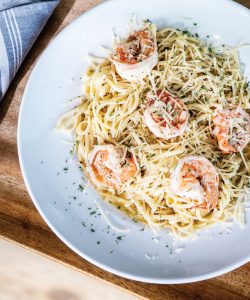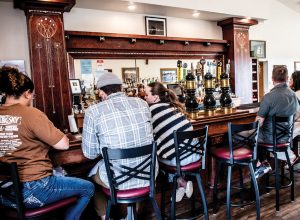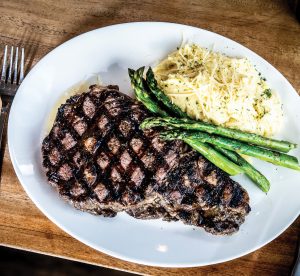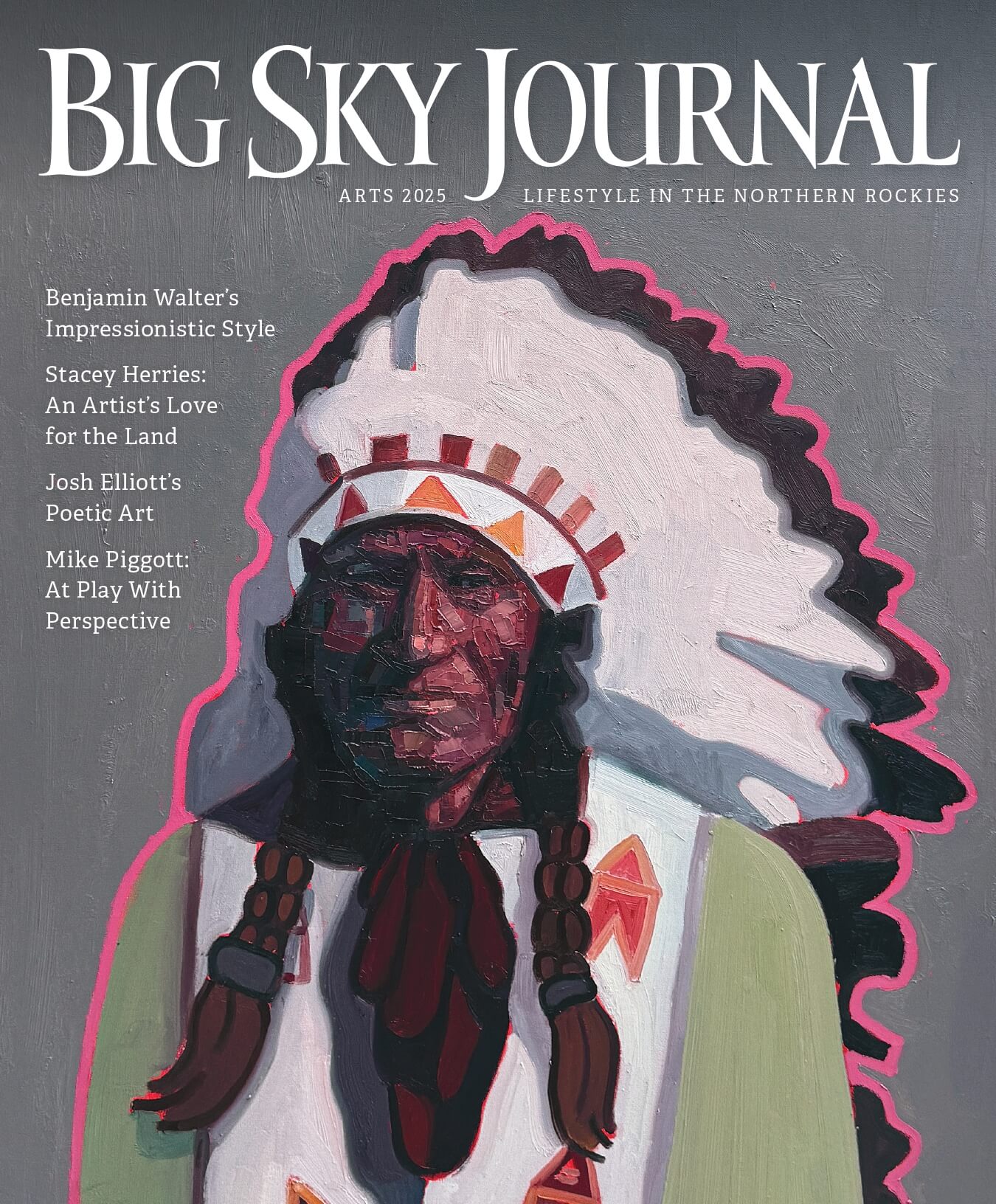
29 May Dining Out: A Visiting Place
Phil Lalich doesn’t mind saying that he got into the restaurant business for the first time at 67 years old. “I had a weak moment,” he says of his 2017 decision to buy LaHood Park Steakhouse near Cardwell, Montana. But after 25 years of ranching near Belt, Montana, another 20 buying and selling bulls and grading carcasses for the Certified Angus Beef brand, and still another 20 working with his son in their custom woodshop in Belgrade, Montana, it’s clear that Lalich wouldn’t know a weak moment if it led him around by the ear.

Owner Phil Lalich and Chef Sarah Moran pose with ranch-dog-turned-restaurant-dog Sophie on the deck overlooking the Jefferson River.
The years don’t add up because Lalich is always doing more than one thing, and he doesn’t do anything halfway. “I guess I’m kind of in retirement,” he says, now at 75, from behind the mahogany-and-abalone bar at his steakhouse on a Thursday spring evening.
Yeah, right.
LaHood Park Steakhouse and Tavern is set where the Jefferson River flows east-southeast into a narrow canyon, in a place named for Shadan LaHood, a Lebanese immigrant who came to Montana in 1902 and opened a general store where the steakhouse stands today and a hotel and gas station nearby. Not far from the interstate and just off Montana Highway 2, LaHood Park has long been a stopping point, a meeting place, a place for rest. Lewis and Clark camped here in August of 1805 and recorded in their journals that they killed and feasted on two elk. In the 1930s, the area was a temporary home for 200 Civil Conservation Corp members who were working in Yellowstone National Park and making Lewis & Clark Caverns accessible to the public. The setting is bucolic. Your heart beats a bit slower the moment you sit down here.

Though the town was established in 1928, Lalich bought LaHood Park Steakhouse in 2017 and maintains a clean atmosphere in the dining room and tavern. Light from the abundant windows adds to the beauty of the space.
Nearly every table in the dining room, and a few in the tavern, has a view out the expansive windows facing the river, where wildlife is a near-constant presence. As he seats us, Bernie, the host and our server, tells us to watch for deer swimming across the Jefferson to graze in one of the fields nearby. There was a moose the night before, he says. But it’s spring, and tonight, the Canada geese are coming in to rest and feed. So are we, it turns out. There is every reason to linger.
Though the menu has the heft of something from an old-school supper club, the steakhouse offerings are relatively modest. There are a handful of appetizers and salads, four options for steakburgers, four steaks — all of which are hand-cut in-house — a few weekend specials, seafood options, pasta selections, and some other favorites. But take my word, Lalich and Chef Sarah Moran — who hasn’t missed a day of work since she started at LaHood in 2017 — are precisionists: If it isn’t perfect, it isn’t on the menu.

Driving up to LaHood Steakhouse is part of the adventure. It might as well be a favorite fishing hole or a beloved hiking trail, set as it is above the river in the open landscape.
For starters, we order the blackened tenderloin tips, cooked medium rare, with goat cheese crumbles. It looks like a dessert when Bernie puts it between us. There’s a glaze decorating the dish, and the meat is plated atop a cumin-heavy gravy that is good enough to drink. Lalich comes to the table to see how we like it. We marvel. We rave. We tell him how perfectly cooked the meat is, how tender. “Medium and medium rare are not related,” he says, pleased that we chose the latter. “And don’t forget the peppadew,” he says, pointing to the small, bright pickled pepper atop the dish. We don’t. And are glad.
For dinner, I order a Cowboy Burger with huckleberry barbecue sauce, bacon, crispy onion strings, and pepperjack cheese. Lalich tells me the burger is ground from each end of the ribeyes and New York strips, a few racks of which are being dry-aged or butter-aged in the immaculate cold storage room Lalich let us peek into before dinner. My partner laughs as he orders the “small” ribeye, as if a pound of Certified Angus Beef could ever be small. There are all sorts of toppings he could add — king crab, mushroom confit, grilled onions, bacon jam, chipotle compound butter — but he wants just the steak. And when it comes medium rare, he is pleased as punch. We both are. There’s plenty of sharing.

The Chicago, Milwaukee and St. Paul Railroad built a line through the Jefferson Canyon in 1908. The old railroad runs alongside Highway 2 and the Jefferson River, near LaHood.
If we’d had more room in our bellies, we’d have ordered something Italian: shrimp scampi, maybe, on linguini, or fettuccine Alfredo. Moran grew up in Puget Sound, where her family owned and operated a deli. She did her training at an Italian restaurant in Tacoma and loves that Italian cuisine gives her a chance to “play.” It’s this flair for Italian flavors that makes LaHood what Moran and Lalich agree is a “steakhouse-plus.”
It’s not a stretch to imagine that everyone in LaHood is happy to be there. There are ranch families with kids, even a baby at one table. Another table of all women is living it up. There are a few couples on dates, and a few one-tops in the bar. Lalich stops what he’s doing to visit with almost every guest as they walk in or out. Even Chef Moran pops out of the kitchen door to say goodbye to a beloved regular.
“I want people to leave here happy and full,” Lalich says. Though he clings to his old-time rancher persona, it’s clear that Lalich loves visiting with folks, loves feeding them, loves making them one of LaHood’s Famous Margaritas or an Old Fashioned. It’s a privilege and a delight to be in the presence of someone who loves what they’re doing.

The shrimp scampi with a garlic, butter, and white wine sauce is testament to Chef Moran’s Italian culinary training and one of the dishes that makes LaHood a “steakhouse-plus.”
Lalich grew up in Butte, Montana, where his father owned The Montana Bar. His mother was a teetotaler. He describes how, when he was 5, his father started taking him around the state, fishing and visiting hot springs, a pastime Lalich still enjoys 70 years on. Lalich likes to go to Shawn O’Donnell’s in Butte, Campione in Livingston, and Chico Hot Springs in Paradise Valley. But when I ask if he ever orders a steak anywhere but here, he shakes his head at the silliness of the question.
This is a man who raised cattle for 25 years, studied meat science at Texas A&M, and dedicated decades of his life to improving the quality of meat through selective breeding. Can you blame him for wanting a perfect steak every time? Or for wanting to offer such a gift to anyone who enters his establishment?

The tavern is a lively spot, but never unruly. Among the favorite cocktails for which the tavern is known are LaHood’s Famous Margarita, Old Fashioned, and Paloma.
Four years into his new gig, in September 2021, tragedy struck when a fire burned the steakhouse to the ground. Lalich had to consider whether to rebuild, but not for long. He’d built something special at LaHood, and he liked the way people made it “a visiting place. No one here has ever met a stranger,” he describes. So, with his friend Jimmy Robertson and Jimmy’s two sons-in-law, Lalich rebuilt the place, board by board. In the tavern, he points to a wood carving of a phoenix he commissioned from artist Michael S. Maydak. Carved from a semi-burned beam from the old steakhouse, the metaphor is obvious. “It was damn sure a labor of love,” Lalich says of the process that took a year.
Speaking of love, his father’s legacy looms large in the restaurant. The mahogany bar and back bar — inlaid with abalone and brought back to life with more than 1,000 hours of restoration work that Lalich did himself — once stood in his father’s Montana Bar. Even his work ethic — Lalich is in-house every day — comes from his father. “The old man told me, ‘If you’re going to own your own business, you have to open the mail every day,’” Lalich says. And with that, he hurries off to clear a table.
LaHood Park Steakhouse and Tavern is open Wednesday through Sunday, from 4 to 9 p.m. Reservations are strongly encouraged.

Beef Tips
When he was a boy, Phil Lalich read somewhere that beef contains all nine essential amino acids that the human body needs to sustain life but cannot produce on its own. The fact fascinated him. “I remember thinking, If things get really bad, I can survive on beef.” But it’s clear that life is about much more than surviving for Lalich. Shaped by his understanding of beef as a complete protein, Lalich has spent his life studying, perfecting, and delighting in what he sees as the “perfect food.” Lalich says the reason he serves only Certified Angus Beef at LaHood Park Steakhouse is that the certification process is concerned with all three palatability traits — tenderness, juiciness, and flavor — and the brand’s 10 specifications for quality ensure the best-tasting steak every time.
To be branded Certified Angus Beef, cattle must meet 10 quality standards addressing marbling, maturity, weight, muscling, and visual quality. After ensuring the quality of every piece of meat that comes into their kitchen — all of which is hand-cut in-house by Chef Sarah Moran — Lalich then focuses on the cut, aging process, and preparation. Each cut on the LaHood menu is uniquely characterized and, thus, ideal for specific preparations.
TENDERLOIN is an oblong muscle extending along the rear portion of the spine, behind the kidney, from the hip bone to the 13th rib. Its job is to protect vital organs; as such, there isn’t much movement, so there is limited marbling and supreme tenderness.
RIBEYE comes from the primal cut between the sixth and 12th ribs of a long, tender muscle that runs from the hip bone to the shoulder blade. It’s known for abundant marbling that is enhanced by a hanging and aging process through which the marbling blossoms.
NEW YORK STRIP is a boneless cut from the same muscle as the tenderloin, but it’s the top portion of the short loin, located behind the ribs. This cut is known for its tight-textured tenderness, marbling, and robust flavor.
PRIME RIB comes from the same primal cut as the ribeye, at the forequarter of the animal, under the front of the backbone. But rather than cutting each individual steak for ribeyes, the prime rib contains up to seven ribs with generous marbling and is seared, then roasted slowly under low heat to amplify the tenderness.
Carter Walker is the author of several guidebooks, including two upcoming editions of Moon Montana & Wyoming (November 2025) and Moon Yellowstone to Glacier National Park Road Trip (May 2026). She spends a lot of time on the road between Montana’s Horseshoe Hills and Yaak Valley.
Photographer Lynn Donaldson shoots regularly for National Geographic, National Geographic Traveler, Travel & Leisure, Sunset, and The New York Times. The founder and editor of the Montana food and travel blog The Last Best Plates, Donaldson lives outside of Livingston, Montana with her husband and three children.




No Comments